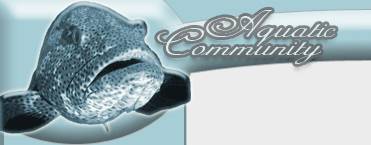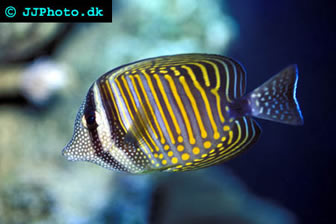Desjardinii Tang
Zebrasoma desjardinii
Zebrasoma desjardinii is known under several different names in English, including Desjardinii tang, Desjardin's sailfin tang, Red Sea sailfin tang, and Indian sailfin surgeonfish.
Zebrasoma desjardinii has not been evaluated for the IUCN Red List of Threatened Species.
Geographical range, habitat and habits
The Desjardinii tang lives in the Indian Ocean. Its geographical range stretches from the Red Sea and East Africa (down to Natal in South Africa) to India, Java and the Cocos-Keeling Islands. It has not been encountered in the waters of the Christmas Island.
Desjardinii tangs inhabit lagoons, sheltered reefs and seaward reefs down to a depth of roughly 30 meters / 100 feet. Juveniles prefer to stay in sheltered lagoons and inner reef areas where they live solitary, usually among staghorn corals. Adults are typically encountered in pairs or in small groups in rocky environments. This is a day-active species.
Size and appearance
The Desjardinii tang is one of the largest members of the genus Zebrasoma and the largest scientifically measured specimen was 40.0 cm / 15.7 in.
The Desjardinii tang is known for its attractive colouration and patterning. The body is adorned with narrow lines of black, white and yellow. The stripes run vertically on the upper part of the body and form horizontal arches on both anal and dorsal fins. You can also see two broad dark vertical bands; one that runs through the eye and one that is located right behind the first one. The lower part of the body is decorated with yellow to orange spots which extends into the anal fin, and the caudal fin is also embellished with light spotting. The spots will usually not appear until the fish matures into adulthood.
The Desjardinii tang can rapidly change its colour. The base colour can for instance vary from brown to gray and the body can develop a pale blue sheen. The intensity of all the bands and spots can also change dramatically from one second to the other.
When the Desjardinii tang extends its fin, the height of the fish is roughly the same as the length and this gives the fish a disc-like shape. Just like all the other sailfin tangs, this species has an extended snout.
A sharp spine (“scalpel”) located on each side of the caudal peduncle is used for defence and to establish dominance. When it is not needed, the tang will keep it folded down inside a groove.
The Desjardinii tang (Zebrasoma desjardinii) and the Pacific sailfin tang (Zebrasoma veliferum) looks very similar to each other when they are young. As they mature, the Desjardinii tang will however become lighter in colour and develop spots while its close relative keeps a look quite similar to its juvenile appearance. The Desjardinii tang inhabits the Indian Ocean and the Red Sea while the Pacific sailfin tang is found in the Pacific.
Desjardinii Tang care
The Desjardinii tang is usually kept in large community aquariums with other relatively peaceful species. Adding the Desjardinii tang last will decrease the risk of skirmishes. Housing it with other members of its own species or genus is not advisable.
A small juvenile Desjardinii tang can be kept in a 75 gallon / 285 litre aquarium but it will eventually need at least 125 gallons / 475 litres as it grows older and bigger. It is important to provide it with plenty of space to swim around in as well as suitable hiding spots such as crevices and caves among rockwork and corals. Live rock and live sand will provide the fish with food and give it an opportunity to carry out its natural feeding behaviour.
The Desjardinii tang is considered reef safe; it will leave both corals and mobile invertebrates alone. This large and powerful fish may however accidentally topple corals while swimming around in the aquarium and keeping corals safely glued down is therefore recommended.
The Desjardinii tang is a really hardy surgeonfish once it has acclimatized itself to its new home. (Generally speaking, it is easier for juveniles to acclimatize to the aquarium.) The recommended water temperature when keeping Desjardinii tangs is 74 -82° F (23 - 28° C) since this fish hails from tropical waters. The pH-value should be in the 8.1-8.4 range and the specific gravity from 1.020 to 1.025. Keep the oxygen level really high; turbulent water movements are definitely recommended.
Just like the other members of its family, the Desjardinii tang does not produce a lot of mucus and is therefore fairly prone to skin disease. The Desjardinii tang is however known for being more disease resistant than most of its family members. In the wild, the Desjardinii tang will normally deal with parasites by seeking out cleaner wrasses and let them remove the parasites. It can therefore be a good idea to provide your Desjardinii tang with some cleaners in the aquarium as well, such as Neon Gobies (Gobiosoma sp.) or cleaner shrimps.
Be careful when handling your Desjardinii tang because the sharp spines can inflict painful wounds. The pain is known to last for hours and the risk of infection is high. The affected area may also swell up and become discoloured.
Prolonged and/or frequent use of copper medicines is not recommended since it can harm the important microfauna present in the digestive system of this fish.
Feeding Desjardinii Tang
The Desjardinii tang feeds chiefly on filamentous algae in the wild, e.g. Valonia and Bryopsis, but it will also ingest macrophytes like Caulerpa spp. It scrapes the algae off hard surfaces with its specially adapted teeth and mouth.
In the aquarium, it is important to give the Desjardinii tang with a varied diet to ensure optimal health. Natural algae growth should be encouraged since it will provide the fish with a constantly accessible source of food and allow the tang to carry out its natural grazing behaviour. This species is known to appreciate several algae types shunned by a lot of other famous algae eaters, such as hair algae.
In addition to naturally occurring food in the aquarium, you should feed your tang plenty of green food, e.g. blanched romaine lettuce and boiled broccoli. Fresh and dried algae will be greatly appreciated, e.g. nori from your local Asian food store and spirulina based foods. It is advisable to include a high-quality flake food or pellet rich in vitamin C in the diet, since vitamin deficiencies may increase the risk of lateral line disease in tangs. In addition to this, the Desjardinii tang must be given meaty foods once in a while to stay healthy. You can for instance feed it suitably sized shrimps.
Feed your Desjardinii tang many small servings throughout the day instead of just one or two big portions. The Desjardinii tang can be trained to accept food from your hand as soon as it feels safe in the aquarium.
Breeding Desjardinii Tang
It is hard to sex Desjardinii tangs based on outer appearance.
Very little is known about the breeding behaviour of the Desjardinii tang, but breeding might be the reason why they sometimes congregate in larger groups in the wild. As far as we know, none of the attempts to breed Desjardinii tang in aquaria has been very successful.
Surgeonfish - Tang Articles:
Achilles Surgeonfish – Acanthurus achilles
Atlantic Blue Tang – Acanthurus coeruleus
Blue Hippo Tang – Paracanthurus hepatus
Chevron Tang – Ctenochaetus hawaiiensis
Clown Surgeonfish – Acanthurus lineatus
Convict Surgeonfish – Acanthurus triostegus
Kole Tang – Ctenochaetus strigosus
Mimic Surgeonfish – Acanthurus pyroferus
Naso Tang – Naso lituratus
Orangeshoulder Surgeonfish – Acanthurus olivaceus
Powder Blue Tang – Acanthurus leucosternon
Powder Brown Tang – Acanthurus japonica
Purple Tang – Zebrasoma xanthurum
Sailfin Tang – Zebrasoma veliferum
Scopas Tang – Zebrasoma scopas
Whitecheek Surgeonfish – Acanthurus nigricans
Yellow Tang – Zebrasoma flavescens

